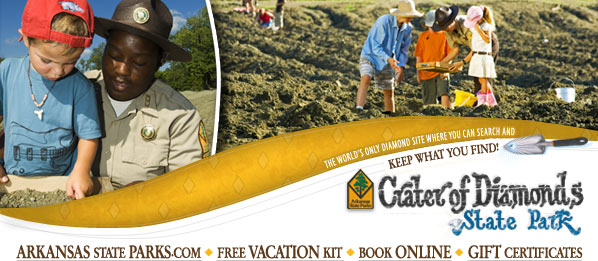
|
Mystery rocks By Margi Jenks One of the fun parts of my job at the Crater of Diamonds State Park is what I call “mystery rocks”. No, these are not rocks endowed with some mysterious property. Instead, visitors bring these rocks to the diamond mine, hoping that someone will be able to tell them the name and perhaps the origin of the rock or mineral. So, I call them “mystery” rocks because that rock has very likely been a curiosity and mystery to them, sometimes for a long time. Often a “mystery rock” visitor will tell me that the rock has been sitting on a shelf in their garage for years, or that they were given the rock by someone in their family. I must admit that it always brings a smile to my face when one of the clerks tells me that they have a visitor that wants to talk to me about a rock that is not from our diamond search area. I think it is fun to see what our visitors have collected that is interesting enough to them to bring the rock with them when they come to search for diamonds. I have been asked to identify rocks from Poland, Africa, Michigan, Oklahoma, and other parts of Arkansas. I always do my best to figure out an answer to the mystery. I am a geologist, so I have training that helps me make educated guesses about most rocks and minerals. I also spent 20 years mapping and studying all types of minerals and rocks in the Pacific Northwest--Oregon, Washington, and Idaho. But, just as in other professions, like doctors and biologists, geologists come in different flavors with different expertise areas. My expertise areas are volcanoes and ancient large lakes. The geologists who study minerals and rocks are called mineralogists and petrologists, respectively. Other non-geologists who have experience, especially with gems and minerals, are gemologists and rock hounds. Gemologists have had training in the identification and evaluation of gems and minerals. Rock hounds have practical experience searching for all kinds of rocks and minerals. Since I don’t have special rock and mineral training, like mineralogists and petrologists, if I can’t figure out the mystery, I try to direct the mystery rock visitor to other experts, who might be better suited to identifying their rock. The second problem that I have with identifying mystery rocks is that most geologists have experience with the rocks and minerals in a particular area. Unless the mystery rock is a simple mineral, like “it’s a quartz crystal”, it almost always requires the context of “place” to figure out the mystery. Thus, I had a hard time coming up with the identifications for the Polish and African mystery rocks, because I know very little about the geology of those places. However, I do know how to find geologists who would be in a better situation to make the identification. All 50 states have state departments who specialize in the rocks and minerals of that state. For example, the Arkansas Geological Survey is in Little Rock, http://www.geology.ar.gov/home/index.htm. When I worked for the Idaho Geological Survey and Oregon Department of Geology and Mineral Industries I often was asked to identify mystery rocks found by those state’s citizens. The United States and other countries also have national geological surveys, like the U.S. Geological Survey, http://www.usgs.gov/, which has a number of offices around the country. Other great resources for rock and mineral identifications are the Geology Departments at all state universities and some private colleges. Many of them have staff mineralogists and petrologists who are happy to try to figure out any “mystery rocks”. So, while I always enjoy the interesting and beautiful “mystery rocks” that are brought to the diamond mine, I am just as happy to make referrals that may yield more accurate and precise identifications than my educated guesses. If you have an interesting rock and are wondering what it might be, I suggest you first try your local rock and mineral experts, including rock shops and gemologists. When that doesn’t seem to end with a satisfactory answer, then please bring them to the diamond mine. I am always happy when “mystery rocks” interrupt my day. Search area last plowed: End of January, 2014; Most recent significant rainstorms: 1.3”, Saturday, March 15, 2014 Total diamonds found in 2014: 66 Diamonds registered for March 10-March 16, 2014 (100 points = 1 carat): March 10 - Adam Hardin, Norton, OH, 8 pt. yellow, 17 pt. white; Cliff Haskett, Riviera, TX, 32 pt. brown March 11 - Jim Graham, Prescott, AR, 3 pt. white, 5 pt. white, 10 pt. white, 89 pt. brown; Kenneth Shoemaker, AR, 5 pt. white; Al Fling, Leadville, CO, 7 pt. white; Robert Strausbaugh & Adam Hardin, Murfreesboro, AR, 12 pt. white March 12 - Adam Hardin, Norton, OH, 5 pt. yellow, 6 pt. white, 10 pt. white, 18 pt. brown March 13 - Leonard Smith, Brighton, MO, 2 pt. brown March 14, 15, and 16 - No diamonds were registered |

209 State Park Road
Murfreesboro, AR 71958
Email: craterofdiamonds@arkansas.com
Phone: (870) 285-3113
You are currently subscribed to the Crater of Diamonds State Park enewsletter as: &*TO;.
To unsubscribe, go to http://diamondsstatepark.xyz/newsletter/ and click the "Unsubscribe" button.
